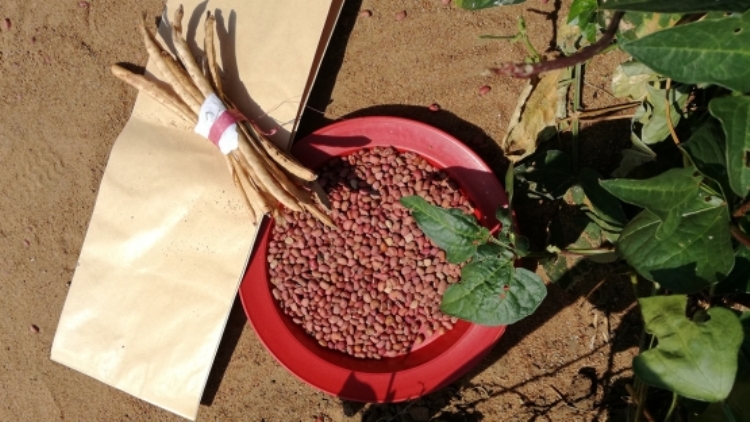Zimbabwe: New mutant cowpea variety helping farmers increase productivity
The new cowpea variety — called CBC5 — was developed using irradiation, a process often used to generate new and useful traits in crops.

Zimbabwean farmers have seen a 10-20% increase in their cowpea yields thanks to the use of a new variety bred using nuclear techniques. The new variety, developed with the support of the IAEA and the Food and Agriculture Organization of the United Nations (FAO), was released in November 2017. It has shown increased drought tolerance and insect resistance, enabling farmers to better cope with the effects of climate change, particularly in more drought-prone areas.
“Climate change, drought, insect pests and diseases and poor soil fertility affect us poor people. We used to predominantly grow maize but have now complemented our food basket with cowpeas,” said farmer Tafirenyika Gumbomunda. “We are combating climate change with advanced technology that has generated drought tolerant cowpeas.”
The new cowpea variety — called CBC5 — was developed using irradiation, a process often used to generate new and useful traits in crops.
A new drought-tolerant cowpea variety
Cowpea is among the four most important legumes produced and consumed in Zimbabwe — and plays a key role in contributing to the country’s food supply. As a subsistence crop, it is mainly grown by resource-poor farmers, said Prince Matova, a plant breeding scientist at Zimbabwe’s Ministry of Agriculture Crop Breeding Institute (CBI). “Unlike other crops, cowpea requires less water and is better suited for poor soils and drier climates. Research underway aims to make this crop even more drought tolerant, nutrient dense and more acceptable to farmers and consumers.” Cowpeas are natural, rich sources of protein, zinc, iron and vitamins.
A niche crop, cowpea grows in the drier areas of Zimbabwe and other parts of sub-Saharan Africa that receive an average of only 250-300 mm of rainfall per year, Matova said, adding that “it is a worry that crop production has been impacted by the effects of climate change.”
“Farmers are also losing their livestock due to starvation as there is barely any grass to feed the livestock in most of these areas particularly during the drier seasons,” he said. Cowpea foliage can be used as livestock fodder, supplementing stock feed during the offseason when pastures are dry. “This new mutant cowpea variety produces high fodder yield, which can be used by farmers to support their crop-livestock farming systems,” Matova added.
Cowpea provides food for the family and the cash generated from its sale can help pay for school fees, said farmer Gumbomunda.
Technology transfer, research, laboratory support and delivery
The CBI sent the cowpea seeds for irradiation to the Plant Breeding and Genetics Laboratory of the Joint FAO/IAEA Division of Nuclear Techniques in Food and Agriculture in Seibersdorf, Austria, and then the seeds were returned to the Institute for selection of varieties with favourable traits from among the many mutants developed.
“Upon receiving the seeds, mutant populations were generated, and selected plants with improved traits were advanced and tested for drought tolerance and yield,” Matova said.
The IAEA, through its technical cooperation programme, has helped Zimbabwean scientists with training and equipment. CBI staff and collaborating partners have received training on breeding techniques, including methodologies for selection of preferred mutant varieties.
Four plant breeders have been trained on the use of fast and efficient drought and insect pest screening methods through fellowships said Matova. Training was also provided in marker-assisted selection techniques, an indirect selection process in which traits of interest are selected in the laboratory based on genetic markers.
In addition, infrastructure support included the establishment at CBI of a molecular laboratory and three screen houses for drought and insect pest tolerance screening. This assistance has enabled a fast process for cowpea variety development, evaluation and selection of mutant lines. The support has also contributed to making future variety development more rigorous and efficient, he highlighted.
- READ MORE ON:
- cowpea
- IAEA
- FAO
- drought
- farmers
- Zimbabwe
- climate change
- irradiation
- technology
ALSO READ
Lok Sabha polls: Congress' Kuldeep Singh Rathore raises plight of apple farmers in Himachal
UNESCO, UNDP, BAZ, and Transmedia support community resilience in Zimbabwe
FOCUS-Bird flu pushes US dairy farmers to ban visitors, chop trees
Rahul highlights the disconnect between farmers demanding MSP and youth seeking jobs with little response
Sugar mills paid Rs 78,000 cr to cane farmers in H1 of 2023-24 season










